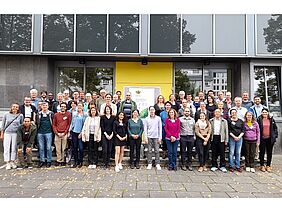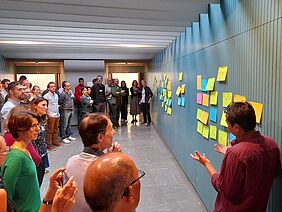The project aims to exploit the advantages of intercropping to design and manage productive, diversified, resilient, profitable and environmentally-friendly cropping systems that are acceptable to farmers and agri-food chain actors. This ambitious aim involves developing 13 co-innovation case studies (CICS) from the EU, the UK, Serbia, Switzerland and Mozambique. The members of these CICS, representing both conventional and organic farming, as well as short and long value chains, have set their own objectives and agenda during this first year.
FiBL Switzerland is leading one case study and on-station experiments to explore the benefits of intercropping wheat with legumes for food:
- The case study is focussing on wheat – fava bean intercropping with on-farm trials
- Scientific set-up with on-station trials on wheat – pea combination
The project started in November 2022, and after one year of activities, the consortium is now sharing its first results. At this year`s meeting, the CICS leaders explained their objectives and planned activities to the scientists and other members of the consortium. These other members included researchers from the environmental and social sciences, humanities, and agronomists who will collaborate with them throughout the process. The participants identified blockages to intercropping and presented the results of an extensive survey that was designed and completed prior to the meeting by the Case Study members. They also described and measured the ecosystem services of intercropping.
Further, they discussed ways of integrating modelling tasks into the overall project to address partners' research questions with the models, explained the data management system to project partners, and even held a workshop to learn how to write convincing policy briefs. All agreed that researchers need to communicate the knowledge derived from their experiments to society and policymakers in a comprehensive way. This is key if a project is to have a real impact.
The first sown crops last August in Austria were a good opportunity to lay the groundwork for the rest of the seasons. Some additional intercropping experiments will start in autumn 2023 and others in the spring of 2024. Combinations include oat-lentil, wheat and legumes such as fava bean and pea, pea-barley or oat-lupin, sugar cane and cover crop (on Réunion island), and even vegetable intercropping, such as broccoli and vetch.
Intercropping has proven to be beneficial for many reasons (such as less use of fertilisers and pesticides, more biodiversity, more water retention, and benefits for pollinator diversity), although new research results will come after four years. A step forward in this project will be to find market opportunities for intercropping products, such as bread, pasta or beer, based on attributes such as taste, health, price or reduced environmental impact.
Further information
Contact
Ludivine Nicod, FiBL Switzerland
Links
- intercropvalues.eu: Project website
- fibl.org: IntercropVALUES in the FiBL project data base
About the project
IntercropVALUES, funded by the European Commission through the Horizon Europe Research and Innovation Program, has a project website and several social media channels where interested parties will be able to find more information about its activities and results in the coming years. A calendar with events, a section for scientific publications, and news are already available on the site. The project is also planning two summer/winter courses for postgraduates, webinars for the processing and machinery industry, training courses for farmers and advisors, and two multi-actor conferences.





